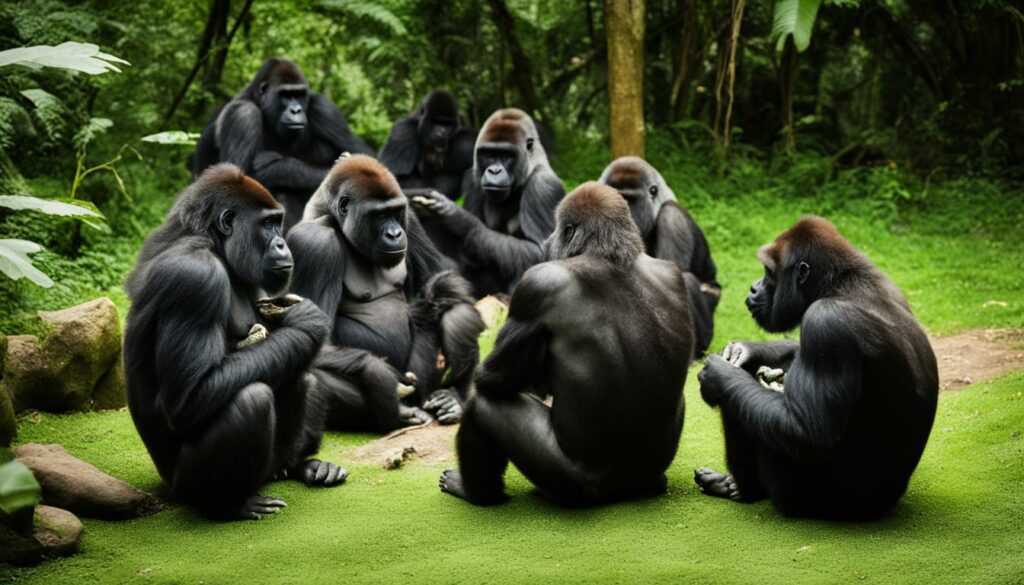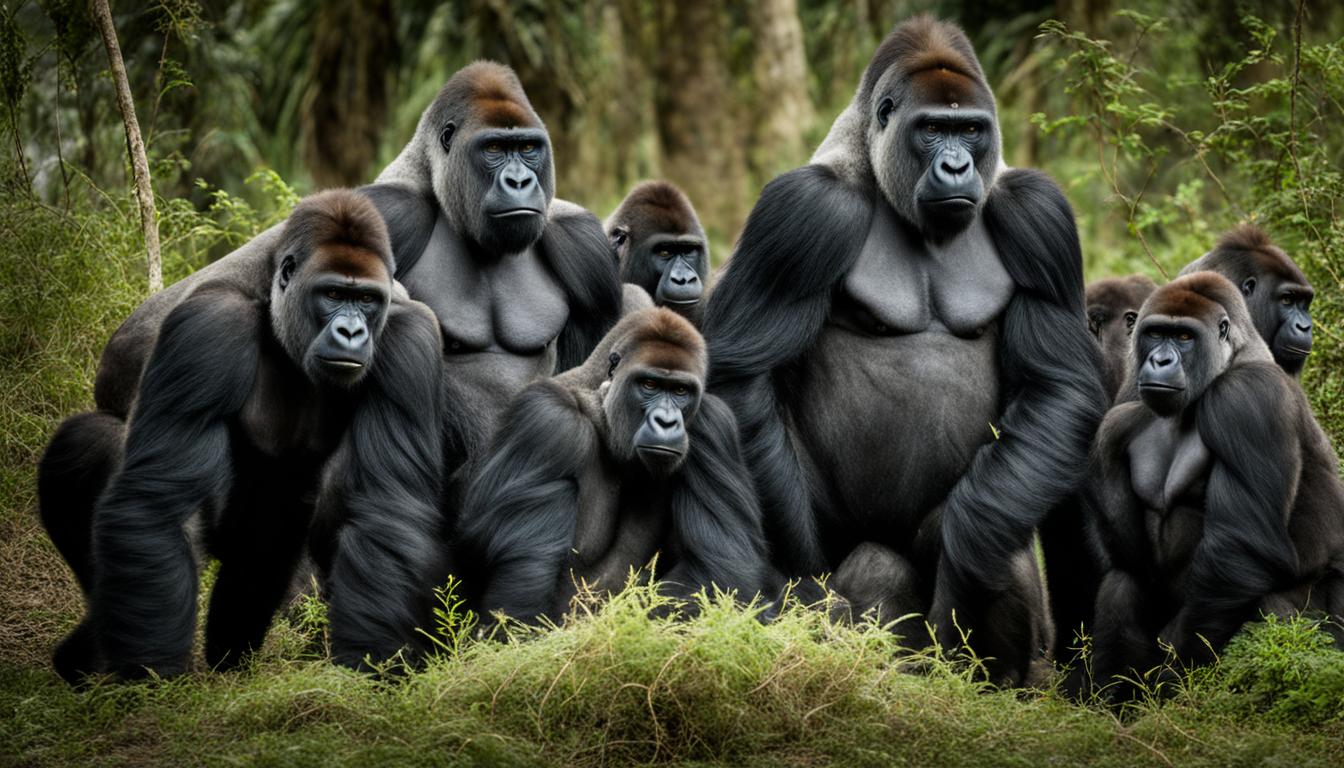Gorilla group dynamics, social structure of gorilla groups, and gorilla group behavior are fascinating topics that shed light on the intricate social lives of these magnificent creatures. Understanding how gorilla groups function can provide valuable insights into their behavior and interactions.
Imagine being part of a gorilla troop, a close-knit community of individuals with distinct roles and relationships. Gorillas live in groups called troops, which can be either family or bachelor groups. Family troops typically consist of one dominant male, known as the silverback, several adult females, and their offspring.
The silverback plays a vital role in the troop’s dynamics. His responsibilities include protecting the group, mediating conflicts, and breeding with the females. In bachelor troops, male gorillas who have left their family troop or been forced out form their own groups. These troops primarily consist of juvenile and older male gorillas.
Communication is key in gorilla groups. They use various methods to convey messages, including gestures, vocalizations, facial expressions, and chest-beat displays. Each behavior serves a specific purpose, whether it’s asserting dominance, expressing playfulness, or maintaining group cohesion.
The Structure of Gorilla Troops
Gorilla troops have a hierarchical structure, with the silverback gorilla serving as the leader. In family troops, the silverback is responsible for protecting the group and making important decisions. Other members of the family form their own hierarchy under the silverback’s leadership. This hierarchical structure ensures stability and organization within the group.
In contrast, bachelor troops are formed by male gorillas who have left their family troop voluntarily or have been forced out. These bachelor groups provide safety and survival in numbers, as well as opportunities for the males to gain experience and socialize with other males. The Association of Zoos and Aquariums (AZA) Species Survival Plan® (SSP) recognizes the importance of bachelor troops and recommends their formation in zoos to increase compatibility among male gorillas.
Overall, the structure of gorilla troops is characterized by a clear hierarchy and distinct roles within the group. The silverback’s leadership ensures the well-being and cohesion of the family troop, while bachelor troops provide opportunities for male gorillas to develop important social skills and eventually establish their own groups.
Communication in Gorilla Groups
Gorillas, like humans, are highly social creatures and rely on communication to navigate their group dynamics. They have developed a complex system of communication that involves various gestures, vocalizations, facial expressions, and even smells. These communication methods allow gorillas to convey messages, establish social hierarchies, and maintain group cohesion.
One important form of communication among gorillas is vocalization. They can produce over 25 different sounds, each with its own meaning. These vocalizations range from grunts and roars to hoots and barks. For example, a “belch vocalization” is often used by silverback gorillas as a sign of dominance, asserting their authority within the group.
In addition to vocalizations, gorillas also use body postures and facial expressions to communicate. The way they hold their bodies, the direction of their gaze, and the movements of their facial muscles can convey various messages. For instance, a display of raised hackles or a stare-down can indicate aggression or a challenge, while a gentle touch or a soft vocalization can express affection and comfort.
| Communication Methods | Description |
|---|---|
| Vocalizations | Gorillas produce a range of sounds to convey different messages, including dominance, aggression, and comfort. |
| Body Postures | The way gorillas hold their bodies and position themselves can communicate aggression, submission, or affection. |
| Facial Expressions | Gorillas use their facial muscles to convey emotions and intentions, such as displays of aggression or affection. |
| Gestures | Gorillas use a variety of gestures, such as chest-beating and arm-raising, to communicate dominance, threat, or playfulness. |
“Gorillas communicate using a combination of vocalizations, body postures, and facial expressions. It is a complex system of communication that allows them to navigate their social dynamics and maintain group cohesion.”
Understanding the nuances of gorilla communication is crucial for interpreting their social interactions and dynamics. By observing their vocalizations, gestures, and body language, researchers can gain insights into the relationships between individuals, the establishment of hierarchies, and the overall functioning of gorilla groups. Communication plays a vital role in gorilla society, allowing them to bond, resolve conflicts, and establish social norms within their troops.
Gorilla Group Dynamics: Social Relationships
Gorilla groups exhibit complex social dynamics, with social relationships playing a crucial role in their overall structure. Within a gorilla group, female gorillas have the option to choose whether to stay in their birth group or transfer to a different group. This choice is often influenced by the need to avoid inbreeding and improve their social status. The proximity to the dominant male, known as the silverback, and the attention received from him determine the status of females within the group.
The silverback gorilla acts as the leader of the group, mediating conflicts and protecting the females from any potential threats. The females, in turn, form relationships mainly centered around their own offspring, engaging in limited friendly interactions with other non-related females. Fertile females and females with young offspring typically hold higher status within the group, as they receive more attention from the silverback.
To gain a deeper understanding of gorilla group dynamics, it is essential to recognize the importance of social relationships within the group. Female gorillas are key players in the cohesion of the group, as their support and decisions can significantly impact the dynamics. By studying how these relationships form and evolve, researchers can gain insights into the intricate social organization of gorilla groups.
| Benefits of Social Relationships in Gorilla Groups | Challenges in Gorilla Group Social Relationships |
|---|---|
|
|
Understanding gorilla group dynamics and the intricacies of their social relationships provides valuable insights into their behavior and social organization. By studying how these relationships form and function, researchers can gain a better understanding of the dynamics within gorilla groups and their impact on the overall structure of the troop.
Gorilla Group Behavior: Female-Female Interactions
When it comes to gorilla group behavior, the interactions between females are of particular interest. While they may compete for the attention of the silverback, they also have the ability to form alliances and engage in social strategies. This complex behavior highlights the importance of female relationships within the group.
One intriguing aspect of female-female interactions is their mating behavior. Some females may choose to mate with multiple males, confusing paternity and thus gaining protection from different males. This strategy not only enhances their own safety but also fosters cohesion within the group. By forming these complex social bonds, females contribute to the overall stability and success of the troop.
The role of females goes beyond mating, as they also play a crucial part in decision-making and group dynamics. Female gorillas have the power to influence the cohesion of the group and the well-being of the silverback. If a silverback loses the support of the females, they may abandon him and seek another male for protection. This showcases the significance of female contributions to gorilla troop cohesion and social organization.
To visualize the intricate dynamics of female-female interactions in gorilla groups, refer to the table below:
This table provides a comprehensive overview of how female gorillas interact within their troops. It highlights key behaviors, such as mating strategies, alliances, and decision-making dynamics. By understanding these intricate connections, we gain a deeper appreciation for the complex social organization of gorilla groups.
Gorilla Group Dynamics: Development and Growth
Gorilla groups, whether family or bachelor troops, go through significant changes and growth over time. Young male gorillas within a group have two potential paths for their future. They can either take over the group from their father, becoming the dominant silverback, or they can leave the group to start their own harem. To impress potential females and establish their dominance, young males mirror the behavior and strength of the silverback. Mountain gorilla males often form bachelor groups before attempting to establish their own harem.
Females within gorilla groups also have choices to make. They can either stay in their current group or transfer to other groups to improve their social status or avoid conflicts. Female gorillas often transfer to new groups to avoid inbreeding and seek protection from dominant silverbacks. The status of females within a group is determined by their proximity to the silverback and the attention they receive from him. Fertile females and those with young offspring typically hold higher status within the group.

Understanding gorilla group dynamics involves recognizing these developmental and growth patterns. Young males have the potential to shape the future of their groups, either by taking over as the dominant silverback or by forming their own harem. Females, on the other hand, have the option to transfer to other groups to improve their status or avoid conflicts. Gorilla troops are complex social structures that provide glimpses of both familiar and unique behaviors, highlighting the fascinating nature of these magnificent creatures.
Conclusion
Gorilla group dynamics offer a captivating glimpse into the social structure and behavioral patterns of these majestic creatures. Whether they belong to family or bachelor groups, gorilla troops are led by dominant silverback males who take on the responsibility of protecting the group and making important decisions. Communication among gorillas is a multi-faceted affair, involving vocalizations, gestures, and facial expressions.
Social relationships within gorilla groups, especially among females, play a crucial role in shaping their dynamics. Females have the option to transfer between groups to improve their status or avoid conflicts, while the silverback mediates conflicts, ensuring harmony within the troop. Female gorillas prioritize their own offspring, but they also engage in strategic behavior, forming alliances and seeking protection from multiple males.
Gorilla group dynamics exhibit both similarities and differences compared to human families. Understanding the complexities of their social structure and behavioral patterns enhances our appreciation for these incredible animals. The dynamics within gorilla groups are a constant reminder of the intricate connections and interactions found in the animal kingdom.
Do gorilla group dynamics affect their reproduction cycle?
Yes, gorilla group dynamics have a significant impact on their reproduction cycle. In a cohesive and stable group, dominant males have better access to females, leading to higher mating success. This directly affects the overall gorilla reproduction cycle, resulting in more offspring and a healthier population.
FAQ
How do gorilla groups function?
Gorilla groups, known as troops, can be either family or bachelor groups. Family troops consist of one dominant male (the silverback), adult females, and their offspring. The silverback protects the group, mediates conflicts, and breeds with the females. Bachelor troops are formed when male gorillas leave their family troop or are forced out and consist of juvenile and older males.
What is the structure of gorilla troops?
Gorilla troops have a hierarchical structure, with the silverback being the leader. In family troops, the silverback is responsible for protecting the group and making decisions. Other members of the family form their own hierarchy under the silverback. Bachelor troops are formed by males who have left their family troop and are a natural response for safety and survival in numbers.
How do gorillas communicate within their groups?
Gorillas communicate through various means, including gestures, vocalizations, facial expressions, and chest-beat displays. They can produce over 25 different sounds to convey different messages. Communication can vary depending on the group and the age of the gorilla.
What role do social relationships play in gorilla groups?
Social relationships are significant in gorilla group dynamics. Female gorillas can choose to stay in their group or transfer to another group to avoid inbreeding. The status of females within a group is determined by their proximity to the silverback and their attention from him. The silverback mediates conflicts and protects the females from outsiders.
How do female gorillas interact with each other?
Female gorillas mainly focus on their own offspring, with limited friendly interactions with other non-related females. They may compete for the attention of the silverback but can also form alliances and engage in social strategies. Some females may mate with multiple males, confusing paternity and gaining protection from different males.
How do gorilla groups develop and grow?
Young males within a group have the opportunity to either take over the group from their father or leave to start their own harem. They impress potential females through displays of strength and behavior mirroring that of the silverback. Female gorillas have the option to transfer to other groups to improve their status or avoid conflict.
What can we learn from gorilla group dynamics?
Gorilla group dynamics reveal a social structure that is both similar and different from human families. Understanding the nuances of gorilla group behavior and social organization enhances our appreciation for these magnificent creatures.











